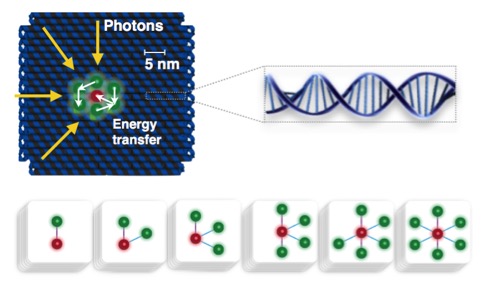Submitted by Dr Nalin Patel on Tue, 04/10/2016 - 12:21
The remarkable performance and quantum efficiency of biological light-harvesting complexes has prompted a multidisciplinary interest in engineering biologically inspired antenna systems as a possible route to novel solar cell technologies. Published in Nano letters, the research groups of Dr Alex Chin (Winton Advanced Research Fellow) and Dr Ulrich Keyser at the Physics Department, University of Cambridge, together with Professor Philip Tinnefeld at TU Braunschweig, Germany and Professor Stephen Emmott at Microsoft Research have demonstrated an artificial, programmable antenna system on a DNA origami platform, enabling them to mimic some of the exquisite nanoengineering of biological light harvesting and explore the optimal co-ordination of pigments in efficient antennas.
DNA origami has emerged as a powerful tool to organise photoactive molecules with nanometer accuracy and full geometric freedom in complex 2D and 3D topologies. Creating a library of over 40 assembled antenna structures, they systematically analysed the light-harvesting efficiency with respect to the geometry and number of “donor” pigments (green, in fig.1) that can capture and transfer photonic energy to an “acceptor” (red) pigment, which is the primary function of photosynthetic antenna complexes. Using the theory of Forster energy transfer, the team were able to predict the efficiency and best geometric arrangement of pigments for this task, which was verified by both ensemble and intricate single-molecule measurement techniques. Surprisingly, while DNA constructs often suffer from significant structural variations when made in batches, the comparison between single-molecule and ensemble results revealed extremely low inhomogeneity, showing this new origami platform is extremely reliable and provides a robust, programmable substrate for implementing advanced nm-scale antenna design concepts.
Such structural rigidity is a crucial aspect of biological protein-based antenna designs, some of which have even been shown to support quantum mechanical effects. Exploring this hotly debated feature of photosynthetic antennas in a controllable way remains a challenge, but the team’s new results indicate that DNA origami could be a very promising route towards novel, organic and built-to-design light harvesting structures that could be characterised by standard and readily available bulk measurements.

Figure: (Top) A circular antenna of pigments implemented on a “breadboard” of DNA origami. (Bottom) A selection of the individual structures studied to unravel how the light harvesting efficiency of the ring antenna emerges as a function of number of donors and geometry.

